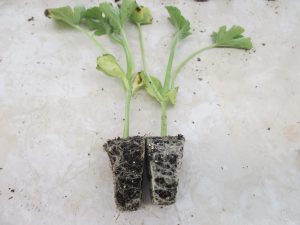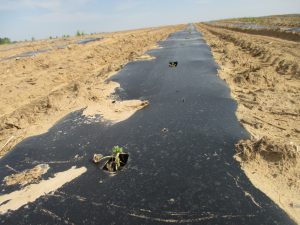In the past week, we have observed a few cases where newly planted watermelon seedlings were severely damaged or dead (Figure 1). In some fields, we observed rotted roots and lower stems caused by fungal pathogens. However, such diseases were in response to the cold soils and would not normally cause problems in warm soils. Most of the dead plants had intact stems, although growers did report seedcorn maggot and wireworm in the stems of a few dead plants. The same thing happened in May 2016. Coincidentally, rain, cloudy days, and lower than normal temperatures were observed in the same period in both years.
Since early May, We have had consecutive days with the lowest temperatures in the 40s°F. There was no risk of frost damage, however, this temperature was low enough to cause chilling injury on young cucurbit plants. This article ‘Protect Early Planted Warm-Season Vegetables from Low Temperature’ I wrote earlier this year explains the difference between frost damage and chilling injury.
What situation should be avoided in terms of planting watermelons?
Always check soil temperature and weather forecast before planting watermelons! Check soil temperatures in the early morning, as this is the lowest point during the day. If soil temperatures are below 60°F, or if the predicted lowest air temperatures are below 50°F in the next few days, there is a high risk of watermelon establishment failure. Remember, soil temperatures above 70°F are the ideal temperatures for cucurbit growth. Under low temperatures, plant roots lose the ability to take up water and nutrients; plants wilt initially. If the low temperature lasts a few days, or plants are suddenly exposed to very sunny days, the injured roots cannot keep up plant water needs, and may die.
If growers have to take the risk, what should be considered?
We understand waiting for warmer days may not always be possible for larger-scale growers, considering available labor, machinery, space, markets, etc. If growers have to take the risk of planting watermelons on cold days. Here are some considerations that may help reduce the risk.
- Plant watermelon seedlings that have developed a solid root ball.
The two plants shown in Figure 2 have similar above-ground plant size. However, the plant on the right has developed a solid root ball. In this case, the right plant is more likely to withstand stress conditions compared to the plant on the left.

Figure 2. Watermelon transplant on the left has a loose root ball compared to transplant on the right. Note the above ground plants are in similar sizes.
- Plant watermelon seedlings that have been well hardened.
During hardening, plants accumulate carbohydrates, thicken cell walls, and root development is triggered. All of these factors help plants better withstand harsh environmental conditions after transplanting. Plants that have been hardened for more than a week in the outdoor conditions are better able to tolerate low temperatures compared to plants that were recently shipped, or just moved out of greenhouses.
- Plant grafted watermelons if they are available.
There is a growing interest among growers to use grafted watermelon plants. The main benefits are to improve yield and control Fusarium wilt. Less commonly realized is that grafted watermelons with squash rootstocks can better tolerant low soil temperatures. We saw pronounced advantages of improving transplant survival rates by using grafted cucumbers under sub-optimal temperature conditions. Grafted cucumbers with squash rootstocks can tolerant soil temperatures in the 40s°F, while the majority of normal cucumber seedlings died under the same conditions. The same principle applies to watermelons.
Considering grafted plants could be more than five times more expensive compared to normal watermelon plants, growers may be reluctant to plant grafted watermelons with a fear of losing those plants. Don’t risk planting expensive grafted plants when there is a danger of frost that may kill the plants regardless of grafted or not. However, if frost is unlikely grafted plants have a higher chance to survive and establish faster than normal watermelon seedlings under low temperatures.
There are several other cultural strategies that help plant survive the adverse conditions, such as planting rye strips for every bed of watermelons; using low tunnels; plant field with the lightest soil first, etc. More information about these strategies were discussed in the article ‘Protect Early Planted Warm-Season Vegetables from Low Temperature’.
